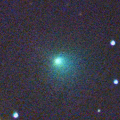
|
New periodic comet discovered in 2016. It had been predicted to return in 2024. But actually, it returned much earlier than predicted. Now it is bright as 11 mag (Jan. 16, Giuseppe Pappa). It passed the perihelion on Jan. 25. In the Southern Hemisphere, it will appear in the morning sky in early February, then it stays observable in excellent condition after that. In the Northern Hemisphere, it will never be observable after this.
Date(TT) R.A. (2000) Decl. Delta r Elong. m1 Best Time(A, h)
Jan. 30 21 49.80 -31 58.8 0.507 0.535 19 10.7 20:45 ( 50, 2)
Feb. 6 21 17.48 -42 15.6 0.504 0.581 26 11.6 20:37 ( 37, 1)
|

|
New bright comet. Now it is 11.0 mag (Jan. 25, Chris Wyatt). It brightens up to 11 mag in early February. In the Northern Hemisphere, it stays observable in excellent condition after this. In the Southern Heimsphere, now it is observable in excellent condition. But it will be getting lower rapidly after February, and it will be unobservable in mid March.
Date(TT) R.A. (2000) Decl. Delta r Elong. m1 Best Time(A, h)
Jan. 30 8 1.32 -22 49.0 0.523 1.417 137 11.1 23:17 (180, 76)
Feb. 6 7 5.76 -3 3.0 0.514 1.428 142 11.1 21:55 (180, 57)
|

|
It brightened up to 5.6 mag in early December (Dec. 9, Marco Goiato). In mid December, it was visible at about 3 mag in the SOHO spacecraft images (Dec. 18, Hirohisa Sato). Now it is not observable. It will appear in the morning sky again in April. But then it will be fainter than 15 mag.
Date(TT) R.A. (2000) Decl. Delta r Elong. m1 Best Time(A, h)
Jan. 30 21 3.89 -5 30.7 2.127 1.186 12 11.4 20:45 ( 64,-24)
Feb. 6 21 25.27 -3 29.6 2.258 1.312 12 11.9 20:37 ( 66,-25)
|
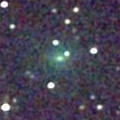
|
Brightened rapidly. Now it is very bright as 12.6 mag (Dec. 25, Ken-ichi Kadota). It will approach to Earth down to 0.46 a.u. in April, and it is expected to brighten up to 9 mag and to be observable in excellent condition. It becomes unobservable temporarily from January to February.
Date(TT) R.A. (2000) Decl. Delta r Elong. m1 Best Time(A, h)
Jan. 30 20 59.37 -15 48.6 2.134 1.151 2 11.8 20:45 ( 55,-18)
Feb. 6 20 55.49 -14 58.7 2.082 1.104 5 11.5 3:50 (301,-15)
|
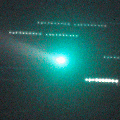
|
It brightened very rapidly in early December. Now it is very bright as 10.6 mag (Jan. 13, Chris Wyatt). In addition, Michael Jager observed two more components of 15-16 mag. It stays observable for a long time in this apparition.
Date(TT) R.A. (2000) Decl. Delta r Elong. m1 Best Time(A, h)
Jan. 30 2 25.23 -3 24.9 0.560 1.073 83 11.6 20:45 (118, 38)
Feb. 6 3 13.63 -1 42.6 0.605 1.143 88 12.4 20:37 (126, 42)
|

|
Now it is bright as 11.9 mag (Jan. 23, Marco Goiato). It stays 12 mag until March. In the Southern Hemisphere, it stays observable in good condition after this. In the Northern Hemisphere, it will never be observable after this.
Date(TT) R.A. (2000) Decl. Delta r Elong. m1 Best Time(A, h)
Jan. 30 15 8.00 -65 55.5 1.925 1.872 72 11.7 3:40 (334, 50)
Feb. 6 15 20.50 -71 57.9 1.913 1.911 74 11.8 3:50 (344, 49)
|
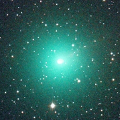
|
It brightened up to 7.3 mag in November (Nov. 7, Marco Goiato). Now it is fading. But it is bright as 11.3 mag still now (Jan. 22, Thomas Lehmann). In the Northern Hemisphere, it stays observable in excellent condition for a long time. In the Southern Hemisphere, it stays locating extremely low after this.
Date(TT) R.A. (2000) Decl. Delta r Elong. m1 Best Time(A, h)
Jan. 30 5 31.52 48 44.5 1.084 1.872 129 12.2 20:53 (180, 6)
Feb. 6 5 39.90 48 41.6 1.201 1.941 124 12.7 20:37 (180, 6)
|
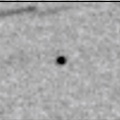
|
It will brighten up to 11.5 mag in spring. However, the condition is very bad in this apparition. It will appear in the morning low sky in March in the Southern Hemisphere, or in June in the Northern Hemisphere.
Date(TT) R.A. (2000) Decl. Delta r Elong. m1 Best Time(A, h)
Jan. 30 19 24.00 -19 14.7 2.403 1.519 20 12.9 3:40 (295, -2)
Feb. 6 19 47.69 -18 53.7 2.364 1.494 21 12.6 3:50 (293, 0)
|
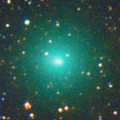
|
It brightened up to 8.2 mag in autumn (Oct. 13, Chris Wyatt). Now it is fading. It has already faded down to 12.3 mag (Jan. 13, Chris Wyatt). In the Southern Hemisphere, it will be unobservable soon. In the Northern Hemisphere, it will be unobservable in late February.
Date(TT) R.A. (2000) Decl. Delta r Elong. m1 Best Time(A, h)
Jan. 30 23 27.66 -6 4.9 2.524 1.882 40 12.7 20:45 ( 86, 4)
Feb. 6 23 43.59 -4 13.4 2.615 1.928 37 13.0 20:37 ( 87, 3)
|

|
First return of a new periodic comet which brightened up to 13 mag in 2009. Now it is bright as 12.5 mag (Jan. 23, Chris Wyatt). It stays observable in good condition while the comet will be fading after this.
Date(TT) R.A. (2000) Decl. Delta r Elong. m1 Best Time(A, h)
Jan. 30 5 37.16 16 47.5 0.479 1.363 134 13.1 20:59 (180, 38)
Feb. 6 5 53.52 19 57.5 0.523 1.388 131 13.4 20:48 (180, 35)
|
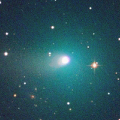
|
Brightened rapidly. It brightened up to 9.7 mag in November (Nov. 15, Chris Wyatt). Now it is fading. But it is bright as 11.7 mag still now (Jan. 13, Osamu Miyazaki). In the Northern Hemisphere, it stays observable in good condition for a long time. In the Southern Hemisphere, it locates extremely low after this.
Date(TT) R.A. (2000) Decl. Delta r Elong. m1 Best Time(A, h)
Jan. 30 2 34.65 36 4.2 1.105 1.572 97 13.3 20:45 (147, 9)
Feb. 6 2 56.32 37 31.8 1.189 1.613 95 13.8 20:37 (148, 8)
|
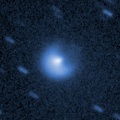
|
Now it is 12.7 mag (Jan. 16, Thomas Lehmann). In the Southern Hemisphere, it will be unobservable in late February.
Date(TT) R.A. (2000) Decl. Delta r Elong. m1 Best Time(A, h)
Jan. 30 2 19.14 23 52.4 5.764 5.854 90 13.6 20:45 (137, 17)
Feb. 6 2 21.66 23 52.2 5.877 5.855 83 13.6 20:37 (134, 14)
|
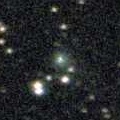
|
Now it is 13.8 mag (Jan. 15, Thomas Lehmann). It will brighten up to 11 mag in winter in 2022. In the Northern Hemisphere, it stays observable in good condition for a long time. In the Southern Hemisphere, it is not observable until 2021 November.
Date(TT) R.A. (2000) Decl. Delta r Elong. m1 Best Time(A, h)
Jan. 30 0 42.81 53 55.9 4.636 4.692 87 13.9 20:45 (145,-17)
Feb. 6 0 52.22 53 22.5 4.672 4.653 82 13.9 20:37 (143,-18)
|
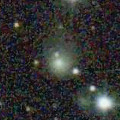
|
Now it is 14.7 mag (Jan. 24, Thomas Lehmann). It is expected to be observable at 5-6 mag for a long time from 2022 to 2023. In the Northern Hemisphere, it is not observable at the high light from 2022 summer to 2023 summer. In the Southern Hemisphere, it is not observable now. But it will be observable in good condition at the high light.
Date(TT) R.A. (2000) Decl. Delta r Elong. m1 Best Time(A, h)
Jan. 30 18 9.64 35 19.9 7.569 7.212 65 14.0 3:40 (239,-18)
Feb. 6 18 13.25 35 34.6 7.477 7.157 67 13.9 3:50 (235,-12)
|
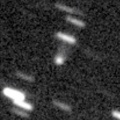
|
It will brighten up to 13 mag from spring to summer. In the Southern Hemisphere, it stays observable in good condition for a long time. In the Northern Hemisphere, it is not observable until July in 2022.
Date(TT) R.A. (2000) Decl. Delta r Elong. m1 Best Time(A, h)
Jan. 30 17 7.11 -52 25.4 4.297 3.824 55 14.0 3:40 (313, 37)
Feb. 6 17 19.45 -53 55.4 4.204 3.803 59 13.9 3:50 (314, 41)
|
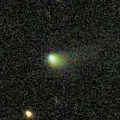
|
It stays 13-14 mag from 2020 to 2021. Appearing in the moring sky. It will be observable in good condition after this in the Southern Hemisphere. It locates somewhat low in the Northern Hemisphere.
Date(TT) R.A. (2000) Decl. Delta r Elong. m1 Best Time(A, h)
Jan. 30 17 35.06 -21 13.5 3.464 2.867 45 14.2 3:40 (282, 20)
Feb. 6 17 46.32 -21 38.5 3.393 2.865 50 14.2 3:50 (279, 26)
|
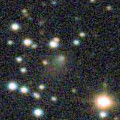
|
Now it is 15.2 mag (Jan. 16, Thomas Lehmann). It stays 14-15 mag until spring. In the Northern Hemisphere, it stays observable in excellent condition. In the Southern Hemisphere, it stays extremely low until spring.
Date(TT) R.A. (2000) Decl. Delta r Elong. m1 Best Time(A, h)
Jan. 30 1 30.47 27 6.0 1.229 1.456 81 14.8 20:45 (130, 7)
Feb. 6 1 53.55 25 33.9 1.228 1.416 78 14.7 20:37 (130, 9)
|

|
It had been observed as 8-9 mag for a long time in 2020. Now it is fading. Appearing in the moring sky. It will be observable in good condition after this in the Southern Hemisphere. It locates extremely low after this in the Northern Hemisphere.
Date(TT) R.A. (2000) Decl. Delta r Elong. m1 Best Time(A, h)
Jan. 30 17 20.70 -30 13.3 4.230 3.659 48 14.8 3:40 (289, 27)
Feb. 6 17 26.50 -31 8.6 4.207 3.726 54 14.9 3:50 (287, 34)
|
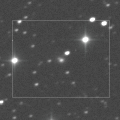
|
Now it is 14.9 mag (Oct. 10, Chris Wyatt). It will brighten up to 13.5 mag in spring. In the Southern Hemisphere, it stays observable in good condition for a long time, although it became unobservable temporarily in December. In the Northern Hemisphere, it is not observable until spring.
Date(TT) R.A. (2000) Decl. Delta r Elong. m1 Best Time(A, h)
Jan. 30 17 50.52 -41 1.8 4.063 3.435 44 14.9 3:40 (303, 26)
Feb. 6 17 51.33 -40 46.1 3.954 3.422 51 14.8 3:50 (300, 33)
|

|
Now it is 15.8 mag (Nov. 5, Ken-ichi Kadota). It is not observable until June.
Date(TT) R.A. (2000) Decl. Delta r Elong. m1 Best Time(A, h)
Jan. 30 22 10.29 -7 20.6 2.966 2.087 22 15.0 20:45 ( 74,-11)
Feb. 6 22 24.40 -5 23.8 2.989 2.083 19 15.0 20:37 ( 74,-13)
|
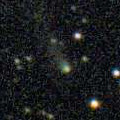
|
Now it is 15.9 mag (Nov. 10, Toshihiko Ikemura, Hirohisa Sato). It will stay at 14 mag for a long time from 2021 to 2022. In the Northern Hemisphere, it stays observable in good condition while brightening gradually, although it became unobservable temporarily in December. In the Southern Hemisphere, it will appear in the morning sky soon. Then it will be observable in good condition.
Date(TT) R.A. (2000) Decl. Delta r Elong. m1 Best Time(A, h)
Jan. 30 18 13.74 3 27.1 6.090 5.424 43 15.2 3:40 (267, -1)
Feb. 6 18 16.34 3 10.8 6.002 5.403 48 15.2 3:50 (262, 6)
|
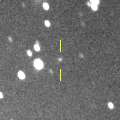
|
Now it is 14.2 mag and visible visually (Jan. 25, Chris Wyatt). It is expected to brighten up to 13 mag in 2022. It is observable in excellent condition in the Southern Hemisphere. In the Northern Hemisphere, it is observable from autumn to winter, but it locating extremely low.
Date(TT) R.A. (2000) Decl. Delta r Elong. m1 Best Time(A, h)
Jan. 30 8 13.49 -40 25.6 5.258 5.829 121 15.3 23:33 ( 0, 85)
Feb. 6 8 10.19 -40 5.2 5.210 5.793 122 15.2 23:02 ( 0, 85)
|

|
Now it is 14.8 mag (Dec. 12, Taras Prystavski). It stays 14-15 mag until the end of 2021. In the Southern Hemisphere, it stays observable in good condition for a long time, although it becomes extremely low temporarily from January to February. In the Northern Hemisphere, it is not observable until June.
Date(TT) R.A. (2000) Decl. Delta r Elong. m1 Best Time(A, h)
Jan. 30 21 31.96 -50 45.3 5.129 4.349 34 15.2 20:45 ( 35, 12)
Feb. 6 21 42.88 -49 29.9 5.124 4.343 34 15.2 20:37 ( 35, 10)
|
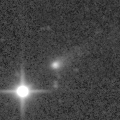
|
Now it is 15.8 mag (Jan. 20, Katsumi Yoshimoto). It is expected to brighten up to 13 mag from spring to summer, and it stays observable in good condition for a long time.
Date(TT) R.A. (2000) Decl. Delta r Elong. m1 Best Time(A, h)
Jan. 30 13 43.67 27 24.9 2.258 2.786 112 15.6 3:40 (201, 24)
Feb. 6 13 50.17 28 9.2 2.148 2.734 116 15.4 3:50 (194, 26)
|

|
First return of a new periodic comet which brightened up to 14-15 mag in 2006. Now it is 16.0 mag (Jan. 10, Toshihiko Ikemura, Hirohisa Sato). It will brighten up to 15-16 mag from February to March, and will be observable in good condition.
Date(TT) R.A. (2000) Decl. Delta r Elong. m1 Best Time(A, h)
Jan. 30 12 40.37 4 28.0 1.019 1.754 122 15.6 3:40 (189, 50)
Feb. 6 12 50.89 5 53.6 0.977 1.757 127 15.5 3:47 (180, 49)
|

|
Now it is 16.3 mag (Nov. 9, Toshihiko Ikemura, Hirohisa Sato). It will brighten up to 14.5 mag from spring to summer. In the Southern Hemisphere, it stays observable in excellent condition for a long time, although it becomes extremely low temporarily from January to February. In the Northern Hemisphere, it is not observable after this.
Date(TT) R.A. (2000) Decl. Delta r Elong. m1 Best Time(A, h)
Jan. 30 21 58.62 -37 6.3 3.650 2.784 24 15.7 20:45 ( 48, 6)
Feb. 6 22 6.58 -37 49.3 3.629 2.762 24 15.7 20:37 ( 46, 5)
|

|
Now it is 17.4 mag (Sept. 16, Blue Mountains Observatory, Leura). It will brighten up to 15.5 mag in early 2021. It stays unobservable until June.
Date(TT) R.A. (2000) Decl. Delta r Elong. m1 Best Time(A, h)
Jan. 30 20 52.10 -23 23.7 2.630 1.653 5 15.7 20:45 ( 49,-13)
Feb. 6 21 13.42 -21 20.2 2.608 1.630 5 15.7 3:50 (308,-13)
|

|
Now it is 14.9 mag (Jan. 22, Thomas Lehmann). In the Northern Hemisphere, it stays observable for a long time while it is getting fainter slowly. In the Southern Hemisphere, it will never be observable again.
Date(TT) R.A. (2000) Decl. Delta r Elong. m1 Best Time(A, h)
Jan. 30 16 37.53 62 18.1 4.997 5.160 93 15.7 3:40 (207,-20)
Feb. 6 16 38.40 63 5.4 5.023 5.207 95 15.8 3:50 (203,-18)
|

|
Five apparitions of this comet was confirmed in 1999, 2004, 2008, 2012 and 2016. It approaches to Sun down to 0.04 a.u. on Jan. 17. It may be observed on the ground in December and February.
Date(TT) R.A. (2000) Decl. Delta r Elong. m1 Best Time(A, h)
Jan. 30 22 12.64 -8 12.0 0.539 0.528 22 15.9 20:45 ( 74, -9)
Feb. 6 23 52.11 3 21.6 0.449 0.722 42 16.8 20:37 ( 96, 1)
|

|
New comet. Now it is 17.7 mag (Jan. 20, Katsumi Yoshimoto). It approaches to Earth down to 0.4 a.u. in February, and it brightens up to 15-16 mag. In the Northern Hemisphere, it stays observable in excellent condition. In the Southern Hemisphere, it is not observable until mid February.
Date(TT) R.A. (2000) Decl. Delta r Elong. m1 Best Time(A, h)
Jan. 30 13 12.32 60 4.7 0.611 1.378 117 16.8 3:40 (187, -5)
Feb. 6 10 32.02 69 33.0 0.481 1.321 124 16.1 1:40 (180,-14)
|
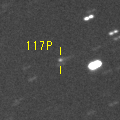
|
Now it is 16.8 mag (Jan. 10, Toshihiko Ikemura, Hirohisa Sato). It will brighten up to 13 mag in 2022. In 2021, it is observable at 15-16 mag in good condition.
Date(TT) R.A. (2000) Decl. Delta r Elong. m1 Best Time(A, h)
Jan. 30 13 42.62 -2 52.2 3.470 3.845 105 16.2 3:40 (217, 52)
Feb. 6 13 44.36 -2 54.9 3.354 3.829 111 16.1 3:50 (203, 56)
|

|
It brightened rapidly and became brighter than expected. Now it is 16.3 mag (Jan. 15, Toshihiko Ikemura, Hirohisa Sato). It is observable in good condition in the Northern Hemisphere. It locates somewhat low in the Southern Hemisphere.
Date(TT) R.A. (2000) Decl. Delta r Elong. m1 Best Time(A, h)
Jan. 30 3 18.16 23 38.1 1.442 1.924 103 16.2 20:45 (149, 24)
Feb. 6 3 30.90 22 58.7 1.518 1.934 98 16.3 20:37 (147, 24)
|

|
New comet. Now it is 16.5 mag (Jan. 14, M. Mattiazzo). It brightens up to 15 mag from spring to summer. In the Southern Hemisphere, it stays observable in good condition until June. In the Northern Hemisphere, it is observable in the low sky from March to May.
Date(TT) R.A. (2000) Decl. Delta r Elong. m1 Best Time(A, h)
Jan. 30 6 3.24 -63 13.7 2.555 2.783 92 16.5 21:23 ( 0, 62)
Feb. 6 5 57.95 -60 57.0 2.482 2.728 93 16.3 20:50 ( 0, 64)
|
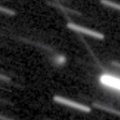
|
Now it is 15.8 mag (Jan. 14, Toshihiko Ikemura, Hirohisa Sato). It is observable at 16 mag from 2020 to 2021. In the Southern Hemisphere, it is not observable until summer.
Date(TT) R.A. (2000) Decl. Delta r Elong. m1 Best Time(A, h)
Jan. 30 22 29.50 45 32.0 6.263 5.951 67 16.3 20:45 (126,-33)
Feb. 6 22 33.79 44 47.9 6.333 5.949 62 16.4 20:37 (124,-35)
|
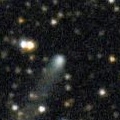
|
Now it is 15.6 mag (Nov. 10, Toshihiko Ikemura, Hirohisa Sato). It stays 15-16 mag for a long time until 2021. In the Northern Hemisphere, it stays observable in good condition for a long time, although it becomes very low temporarily from December to January. In the Southern Hemisphere, it will be observable in the extremely low sky only in next spring.
Date(TT) R.A. (2000) Decl. Delta r Elong. m1 Best Time(A, h)
Jan. 30 19 7.01 26 8.1 5.403 4.836 50 16.4 3:40 (254,-24)
Feb. 6 19 10.31 27 22.8 5.385 4.857 53 16.4 3:50 (249,-18)
|
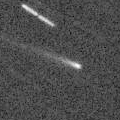
|
Brightening very rapidly. Now it is 16.5 mag, much brighter than expected (Jan. 2, D. Buczynski). It stays 16.5 mag until February. It is observable in excellent condition in the Northern Hemisphere. It locates somewhat low in the Southern Hemisphere.
Date(TT) R.A. (2000) Decl. Delta r Elong. m1 Best Time(A, h)
Jan. 30 2 9.84 13 46.0 1.142 1.440 84 16.4 20:45 (128, 23)
Feb. 6 2 29.76 16 13.2 1.184 1.448 83 16.4 20:37 (130, 21)
|

|
Brightened very rapidly. Now it is 15.5-16.0 mag (Jan. 20, Michael Jager). It stays observable at 16 mag in good condition for a while. It locates low in the Southern Hemisphere.
Date(TT) R.A. (2000) Decl. Delta r Elong. m1 Best Time(A, h)
Jan. 30 3 15.15 26 54.9 1.385 1.876 103 16.6 20:45 (150, 21)
Feb. 6 3 28.39 27 11.3 1.458 1.888 99 16.5 20:37 (149, 20)
|

|
Now it is 16.8 mag (Jan. 17, Toshihiko Ikemura, Hirohisa Sato). In the Northern Hemisphere, it stays observable at 15 mag for a long time from spring to early 2022. In the Southern Hemisphere, it is not observable until the end of 2021.
Date(TT) R.A. (2000) Decl. Delta r Elong. m1 Best Time(A, h)
Jan. 30 19 56.17 46 8.2 3.896 3.593 65 16.8 3:40 (236,-41)
Feb. 6 20 0.45 47 13.9 3.854 3.557 65 16.7 3:50 (233,-35)
|
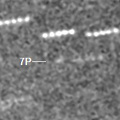
|
Now it is 19.0 mag, much fainter than predicted (Jan. 20, Katsumi Yoshimoto). It will brighten up to 11 mag from May to August. In the Southern Hemisphere, it stays observable in excellent condition for a long time. In the Northern Hemisphere, it stays observable in good condition for a while. But it becomes extremely low after July.
Date(TT) R.A. (2000) Decl. Delta r Elong. m1 Best Time(A, h)
Jan. 30 15 6.86 10 8.1 1.560 1.832 89 17.0 3:40 (230, 30)
Feb. 6 15 23.68 9 58.2 1.457 1.779 91 16.7 3:50 (225, 33)
|
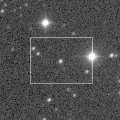
|
Now it is 16.1 mag (Jan. 9, Toshihiko Ikemura, Hirohisa Sato). It is bright as 14.7 mag visually (Jan. 11, Sandor Szabo). It will be fading after this, and will be fainter than 18 mag in April. In the Northern Hemisphere, it stays observable in good condition for a long time after this. In the Southern Hemisphere, it will never be unobservable after this.
Date(TT) R.A. (2000) Decl. Delta r Elong. m1 Best Time(A, h)
Jan. 30 0 55.81 25 41.6 1.338 1.424 73 16.7 20:45 (124, 2)
Feb. 6 1 15.89 29 5.3 1.407 1.459 72 16.8 20:37 (127, 0)
|
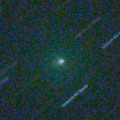
|
It brightened very rapidly up to 12.5 mag in early December (Dec. 7, Michael Jager). Now it is fading. It has already faded down to 16.7 mag (Jan. 15, Toshihiko Ikemura, Hirohisa Sato). It stays observable in excellent condition for a while.
Date(TT) R.A. (2000) Decl. Delta r Elong. m1 Best Time(A, h)
Jan. 30 3 33.73 6 43.9 1.012 1.557 102 16.8 20:45 (143, 41)
Feb. 6 3 51.55 7 8.9 1.092 1.592 99 17.3 20:37 (143, 40)
|

|
Now it is 16.6 mag (Nov. 9, Toshihiko Ikemura, Hirohisa Sato). It stays at 16-17 mag from 2020 to 2021. In the Northern Hemisphere, it stays observable in good condition for a long time. It is not observable in the Southern Hemisphere.
Date(TT) R.A. (2000) Decl. Delta r Elong. m1 Best Time(A, h)
Jan. 30 19 29.16 32 2.9 9.374 8.822 53 16.8 3:40 (251,-31)
Feb. 6 19 32.04 32 40.8 9.355 8.821 54 16.8 3:50 (246,-25)
|
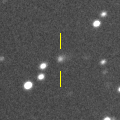
|
It brightened up to 16.1 mag in last winter (Mar. 18, Toshihiko Ikemura, Hirohisa Sato). Now it is 17.6 mag (Jan. 17, Toshihiko Ikemura, Hirohisa Sato). In 2021, it stays observable at 17 mag in good condition until summer.
Date(TT) R.A. (2000) Decl. Delta r Elong. m1 Best Time(A, h)
Jan. 30 13 14.02 -20 27.4 6.502 6.821 104 16.9 3:40 (225, 71)
Feb. 6 13 14.63 -20 22.7 6.407 6.833 111 16.9 3:50 (199, 75)
|

|
Now it is 16.3 mag (Oct. 17, ATLAS-MLO, Mauna Loa). It will be fading slowly.
Date(TT) R.A. (2000) Decl. Delta r Elong. m1 Best Time(A, h)
Jan. 30 18 24.89 -20 2.0 8.052 7.260 34 16.9 3:40 (288, 10)
Feb. 6 18 26.31 -19 43.6 7.996 7.281 41 16.9 3:50 (283, 17)
|

|
Now it is 16.8 mag (Jan. 15, Toshihiko Ikemura, Hirohisa Sato). It is expected to brighten up to 13 mag in 2022. In the Southern Hemisphere, it stays observable in good condition for a long time. In the Northern Hemisphere, it stays observable until June when it brightens up to 16 mag. But it will not be observable at the high light.
Date(TT) R.A. (2000) Decl. Delta r Elong. m1 Best Time(A, h)
Jan. 30 14 10.10 -16 50.4 5.391 5.547 93 17.1 3:40 (242, 59)
Feb. 6 14 8.45 -17 24.5 5.222 5.499 101 17.0 3:50 (228, 66)
|

|
Now it is 17.2 mag (Jan. 5, ATLAS-MLO, Mauna Loa). It stays observable at 16-17 mag from 2021 to 2022.
Date(TT) R.A. (2000) Decl. Delta r Elong. m1 Best Time(A, h)
Jan. 30 14 27.42 -26 26.8 5.038 5.083 87 17.1 3:40 (262, 61)
Feb. 6 14 28.92 -25 58.0 4.900 5.062 93 17.0 3:50 (253, 68)
|

|
It brightened up to 13.8 mag in autumn in 2019 (Sept. 3, 2019, Chris Wyatt). Now it is fading slowly. It has already faded down to 17.2 mag (Jan. 8, Toshihiko Ikemura, Hirohisa Sato). It is already unobservable in the Southern Hemisphere. It will be unobservable in late February also in the Northern Hemisphere.
Date(TT) R.A. (2000) Decl. Delta r Elong. m1 Best Time(A, h)
Jan. 30 23 53.37 6 18.7 7.662 7.088 51 17.1 20:45 (100, 2)
Feb. 6 23 56.12 6 50.5 7.792 7.131 45 17.2 20:37 ( 98, -1)
|

|
Now it is 16.6 mag (Sept. 19, D. Buczynski). It is observable at 16.5-17 mag from spring in 2020 to summer in 2021.
Date(TT) R.A. (2000) Decl. Delta r Elong. m1 Best Time(A, h)
Jan. 30 17 49.53 -9 43.0 5.336 4.683 44 17.2 3:40 (274, 11)
Feb. 6 17 50.91 -10 7.6 5.253 4.692 50 17.2 3:50 (269, 19)
|
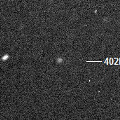
|
First return of a new periodic comet which brightened up to 16 mag from 2003 to 2004. Now it is 16.8 mag (Jan. 13, Toshihiko Ikemura, Hirohisa Sato). It will brighten up to 16 mag in next winter.
Date(TT) R.A. (2000) Decl. Delta r Elong. m1 Best Time(A, h)
Jan. 30 2 38.70 -16 15.0 4.343 4.327 82 17.3 20:45 (106, 49)
Feb. 6 2 41.88 -15 8.2 4.417 4.311 77 17.3 20:37 (105, 45)
|
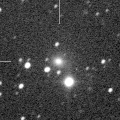
|
It brightened up to 13.5 mag in last winter (Dec. 6, 2019, Chris Wyatt). Now it is fading slowly. Now it is 17.2 mag (Jan. 4, Catalina Sky Survey). In the Southern Hemisphere, it stays observable for a long time. It locates somewhat low in the Northern Hemisphere. Taras Prystavski found its fragmentation on Sept. 12.
Date(TT) R.A. (2000) Decl. Delta r Elong. m1 Best Time(A, h)
Jan. 30 1 15.54 -18 44.9 5.477 5.101 62 17.3 20:45 ( 90, 33)
Feb. 6 1 17.41 -17 25.6 5.613 5.144 57 17.4 20:37 ( 88, 29)
|

|
Now it is 17.7 mag (Sept. 14, Slooh.com Chile Observatory, La Dehesa). It will brighten up to 16.5 mag in summer.
Date(TT) R.A. (2000) Decl. Delta r Elong. m1 Best Time(A, h)
Jan. 30 17 12.89 -36 47.9 5.692 5.131 51 17.4 3:40 (295, 32)
Feb. 6 17 18.02 -36 23.3 5.587 5.114 56 17.3 3:50 (292, 37)
|

|
Now it is 17.9 mag (Dec. 28, J. L. Virlichie, P. Traverse). It is expected to brighten up to 12 mag in 2022. In the Southern Hemisphere, it stays observable in good condition for a long time. In the Northern Hemisphere, it locates extremely low until mid February, then it becomes unobservable until 2022.
Date(TT) R.A. (2000) Decl. Delta r Elong. m1 Best Time(A, h)
Jan. 30 2 45.89 -47 41.5 6.332 6.174 76 17.4 20:45 ( 55, 58)
Feb. 6 2 43.76 -47 2.3 6.344 6.125 72 17.4 20:37 ( 56, 55)
|
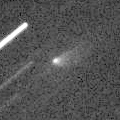
|
First return of a new periodic comet which brightened up to 17 mag in 2013. Now it is 17.8 mag (Jan. 13, Toshihiko Ikemura, Hirohisa Sato). It will be fainter than 18 mag in late February.
Date(TT) R.A. (2000) Decl. Delta r Elong. m1 Best Time(A, h)
Jan. 30 13 46.13 1 19.0 0.509 1.224 105 17.5 3:40 (215, 48)
Feb. 6 13 51.08 -1 18.3 0.515 1.263 110 17.6 3:50 (205, 54)
|

|
Now it is 17.5 mag (Jan. 15, Toshihiko Ikemura, Hirohisa Sato). Although it is an asteroid, it is brightening rapidly. It may brighten up to 11 mag in 2023. In the Northern Hemisphere, it stays observable in good condition for a long time. In the Southern Hemisphere, it is not observable now. It will appear in mid March, but it stays extremely low after that.
Date(TT) R.A. (2000) Decl. Delta r Elong. m1 Best Time(A, h)
Jan. 30 18 28.97 37 45.1 7.830 7.461 64 17.6 3:40 (239,-23)
Feb. 6 18 31.16 38 13.0 7.752 7.416 66 17.5 3:50 (235,-17)
|
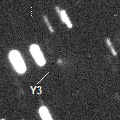
|
New comet. Now it is 17.5 mag (Jan. 17, Toshihiko Ikemura, Hirohisa Sato). It stays 17.5 mag and observable in good condition until March.
Date(TT) R.A. (2000) Decl. Delta r Elong. m1 Best Time(A, h)
Jan. 30 14 45.96 -5 12.2 1.882 2.114 89 17.6 3:40 (238, 45)
Feb. 6 14 51.51 -1 12.4 1.800 2.143 96 17.6 3:50 (226, 47)
|
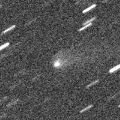
|
Now it is 16.9 mag (Jan. 8, Toshihiko Ikemura, Hirohisa Sato). It stays observable in good condition. But it will be fading after this, and will be fainter than 18 mag in February. It locates somewhat low in the Southern Hemisphere.
Date(TT) R.A. (2000) Decl. Delta r Elong. m1 Best Time(A, h)
Jan. 30 8 2.57 23 26.5 1.700 2.671 167 17.6 23:23 (180, 32)
Feb. 6 7 56.80 23 56.9 1.765 2.709 159 17.9 22:49 (180, 31)
|

|
Now it is 18.7 mag (Jan. 10, Toshihiko Ikemura, Hirohisa Sato). It stays 17-18 mag for a long time from 2021 to 2023.
Date(TT) R.A. (2000) Decl. Delta r Elong. m1 Best Time(A, h)
Jan. 30 11 9.07 9 48.5 4.138 4.980 145 17.7 2:33 (180, 45)
Feb. 6 11 6.70 10 4.4 4.073 4.972 153 17.7 2:03 (180, 45)
|
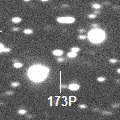
|
Now it is 17.0 mag (Jan. 10, Toshihiko Ikemura, Hirohisa Sato). It is observable at 17-18 mag for a long time from late 2019 to early 2021. It will fade out before it passes the perihelion.
Date(TT) R.A. (2000) Decl. Delta r Elong. m1 Best Time(A, h)
Jan. 30 5 20.21 19 35.9 3.725 4.428 130 17.7 20:45 (179, 35)
Feb. 6 5 19.05 19 55.4 3.802 4.420 123 17.8 20:37 (173, 35)
|
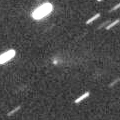
|
Now it is 17.3 mag (Jan. 9, Toshihiko Ikemura, Hirohisa Sato). It stays observable in good condition for a while, but it will be fading after this.
Date(TT) R.A. (2000) Decl. Delta r Elong. m1 Best Time(A, h)
Jan. 30 7 13.46 26 21.5 1.549 2.481 156 17.7 22:34 (180, 29)
Feb. 6 7 9.68 26 52.2 1.623 2.515 148 17.9 22:03 (180, 28)
|
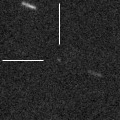
|
Now it is 17.5 mag (Jan. 4, ATLAS-HKO, Haleakala). Although it is an asteroid, it is brightening rapidly. It stays 17-18 mag for a long time from 2021 to 2022. In the Southern Hemisphere, it stays observable in good condition for a long time. In the Northern Hemisphere, it is observable only until May.
Date(TT) R.A. (2000) Decl. Delta r Elong. m1 Best Time(A, h)
Jan. 30 9 15.12 -5 23.0 4.826 5.740 156 17.8 0:40 (180, 60)
Feb. 6 9 8.31 -5 46.6 4.793 5.721 158 17.8 0:05 (180, 61)
|
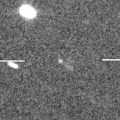
|
Now it is 18.0 mag (Jan. 24, Thomas Lehmann). It is expected to brighten up to 10 mag in 2023. In the Northern Hemisphere, it stays observable in good condition until 2023 autumn. In the Southern Hemipshere, it stays extremely low until mid July, then it becomes unobservable for a while. But it becomes observable in good condition after 2023 summer.
Date(TT) R.A. (2000) Decl. Delta r Elong. m1 Best Time(A, h)
Jan. 30 13 18.26 29 55.0 7.554 8.067 118 18.0 3:40 (195, 24)
Feb. 6 13 16.54 30 47.0 7.424 8.016 123 17.9 3:50 (185, 24)
|

|
It stays 17-18 mag for a long time until 2026. In the Southern Hemisphere, it stays sobservable in good condition for a long time. It is not observable in the Northern Hemisphere.
Date(TT) R.A. (2000) Decl. Delta r Elong. m1 Best Time(A, h)
Jan. 30 9 39.10 -56 55.3 11.354 11.642 104 17.9 1:03 ( 0, 68)
Feb. 6 9 34.04 -57 9.8 11.297 11.625 107 17.9 0:30 ( 0, 68)
|

|
Now it is 18.0 mag (Jan. 13, Toshihiko Ikemura, Hirohisa Sato). It stays 18 mag until 2022. It stays observable in good condition in the Northern Hemisphere. It is not observable in the Southern Hemisphere.
Date(TT) R.A. (2000) Decl. Delta r Elong. m1 Best Time(A, h)
Jan. 30 0 37.79 79 41.2 6.561 6.833 101 17.9 20:45 (169,-31)
Feb. 6 0 47.70 79 25.6 6.604 6.830 99 17.9 20:37 (168,-31)
|
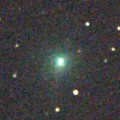
|
It approached to Sun down to 0.34 a.u. on Oct. 20. Then the nucleus was disintegrated. After the perihelion passage, it was observed at 12.5 mag (Oct. 28, Michael Jager). It must have already disappeared.
Date(TT) R.A. (2000) Decl. Delta r Elong. m1 Best Time(A, h)
Jan. 30 15 53.18 6 46.7 2.098 2.110 77 18.9 3:40 (242, 24)
Feb. 6 15 53.92 7 21.0 2.100 2.217 83 19.1 3:50 (234, 30)
|

|
It approached to Sun down to 0.29 a.u. on July 3, and it brightened up to 0.6 mag (Alan Hale). It had been fainter than 15.0 mag in October (Oct. 12, Mitsunori Tsumura). Appearing in the morning sky. But it is fainter than 19.0 mag (Jan. 14, Mitsunori Tsumura). It must be already extremely faint.
Date(TT) R.A. (2000) Decl. Delta r Elong. m1 Best Time(A, h)
Jan. 30 16 39.40 -25 5.2 4.035 3.615 58 20.4 3:40 (279, 33)
Feb. 6 16 40.65 -25 30.1 4.007 3.700 65 20.5 3:50 (275, 41)
|
|
![]()
 C/2018 N2 ( ASASSN )
C/2018 N2 ( ASASSN ) 323P/SOHO
323P/SOHO C/2021 A4 ( NEOWISE )
C/2021 A4 ( NEOWISE ) 117P/Helin-Roman-Alu 1
117P/Helin-Roman-Alu 1 277P/LINEAR
277P/LINEAR C/2021 A7 ( NEOWISE )
C/2021 A7 ( NEOWISE ) C/2019 T3 ( ATLAS )
C/2019 T3 ( ATLAS ) C/2019 K7 ( Smith )
C/2019 K7 ( Smith ) P/2020 T3 ( PanSTARRS )
P/2020 T3 ( PanSTARRS ) P/2020 U2 ( PanSTARRS )
P/2020 U2 ( PanSTARRS ) C/2020 M5 ( ATLAS )
C/2020 M5 ( ATLAS ) 7P/Pons-Winnecke
7P/Pons-Winnecke 162P/Siding Spring
162P/Siding Spring 11P/Tempel-Swift-LINEAR
11P/Tempel-Swift-LINEAR C/2019 O3 ( Palomar )
C/2019 O3 ( Palomar ) C/2019 C1 ( ATLAS )
C/2019 C1 ( ATLAS ) C/2017 U7 ( PanSTARRS )
C/2017 U7 ( PanSTARRS ) C/2020 Y2 ( ATLAS )
C/2020 Y2 ( ATLAS ) C/2020 H6 ( ATLAS )
C/2020 H6 ( ATLAS ) C/2017 B3 ( LINEAR )
C/2017 B3 ( LINEAR ) C/2017 Y2 ( PanSTARRS )
C/2017 Y2 ( PanSTARRS ) 402P/2020 Q3 ( LINEAR )
402P/2020 Q3 ( LINEAR ) C/2018 F4 ( PanSTARRS )
C/2018 F4 ( PanSTARRS ) C/2020 O2 ( Amaral )
C/2020 O2 ( Amaral ) C/2020 R7 ( ATLAS )
C/2020 R7 ( ATLAS ) 405P/2020 U1 ( Lemmon )
405P/2020 U1 ( Lemmon ) A/2019 U5
A/2019 U5 C/2020 Y3 ( ATLAS )
C/2020 Y3 ( ATLAS ) 84P/Giclas
84P/Giclas 99P/Kowal 1
99P/Kowal 1 173P/Mueller 5
173P/Mueller 5 178P/Hug-Bell
178P/Hug-Bell A/2020 F7
A/2020 F7 C/2020 V2 ( ZTF )
C/2020 V2 ( ZTF ) C/2019 E3 ( ATLAS )
C/2019 E3 ( ATLAS ) C/2020 P3 ( ATLAS )
C/2020 P3 ( ATLAS ) C/2020 P1 ( NEOWISE )
C/2020 P1 ( NEOWISE ) C/2020 F3 ( NEOWISE )
C/2020 F3 ( NEOWISE )![]()



























































